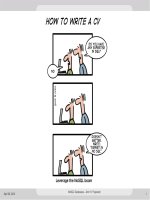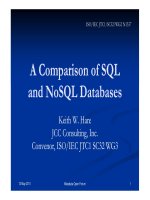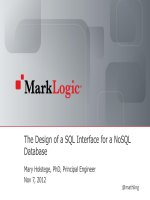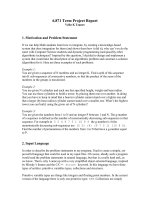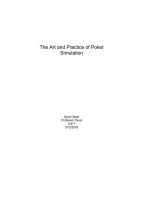TÀI LIỆU - Cao Học Khóa 8 - ĐH CNTT lect09_frames
Bạn đang xem bản rút gọn của tài liệu. Xem và tải ngay bản đầy đủ của tài liệu tại đây (125.86 KB, 23 trang )
Frame-Based Systems
6.871 Lecture 9
Outline
•
•
•
•
•
•
Minsky’s original motivations, observations
Details and use
In the spirit: PIP and Internist-1
Not in the spirit: FRL
Frames summary
Comparison of KR technologies
6.871 – Lecture 9
2
A KR Should Tell You
• What to attend to:
“A Frame …[represents]
…”
• What inferences are recommended:
Minsky “A Framework for Knowledge Representation”
6.871 – Lecture 9
3
Motivations
• A model of human cognition; the structure of
knowledge memory; “common sense” reasoning
• Explain why understanding is …
– fast
6.871 – Lecture 9
4
Motivations
• A model of human cognition; the structure of
knowledge memory; “common sense” reasoning
• Explain why understanding is …
– fast
– anticipatory
6.871 – Lecture 9
5
Motivations
• A model of human cognition; the structure of
knowledge memory; “common sense” reasoning
• Explain why understanding is …
– fast
– anticipatory
– persistent over changes in perspective
6.871 – Lecture 9
6
Motivations
• A model of human cognition; the structure of
knowledge memory; “common sense” reasoning
• Explain why understanding is …
– fast
– anticipatory
– persistent over changes in perspective
– tenacious: “Colorless green ideas sleep furiously.”
Chomsky
6.871 – Lecture 9
7
Motivations and Observations
• A model of human cognition; the structure of knowledge
memory; “common sense” reasoning
• Explain why understanding is …
– fast
– anticipatory
– persistent over changes in perspective
– tenacious: “Colorless green ideas sleep furiously.”
• Meaning is poorly approximated by dictionary defns.
• Memory is full of prototypical situations, richly
interconnected.
6.871 – Lecture 9
8
Use
• Frames are a useful representation when
the task is to …
6.871 – Lecture 9
9
Details
• Frames are networks
– Top levels fixed
– Lower levels hold specific instances of data
– Terminals holding data have easily displaced
defaults
• Inferencing is matching of data to prototype
– Subjective, approximate
• Optional (in the original conception):
– Hierarchy of frames, inheritance
– Daemons: procedures triggered when needed
6.871 – Lecture 9
10
Example
Birthday Party
6.871 – Lecture 9
Have students make suggestions about frame system for birthday party; record on the board.
11
In The Spirit: PIP
• Motivated by data on clinical cognition:
–
–
–
–
Quick focus on little data
Not easily refocused
Ask discriminating questions
Answer is an ordered list of matches
• Wanted expert level performance
6.871 – Lecture 9
12
In The Spirit: PIP
NephroticSyndrome
IS-A
Finding
Finding
Finding
MustNotHave
Sufficient
MayBeCausedBy
MayBeCompBy
Scoring
Edema:
•
•
ClinicalState
Low Serum Albumin
Heavy Proteinuria
…
Proteinuria Absent
Pedal edema and proteinuria > 5gm/day
Acute Glomerulonephritis
Hypovolemia
Massive, symmetrical: 1.0
Not massive, symm.
0.5
Asymmetrical
-0.5
…
70 Disease frames, 500 findings
Variety of interconnections: MustNotHave, ComplicatedBy…
6.871 – Lecture 9
13
PIP’s Machinery
•
•
•
Hypothesis generation via data-driven triggering
– Frame moves into short term memory
– “Nearby” frames become semi-active
Hypothesis testing via calibrating match of data & frame
– Match of frame and data
• Sufficiency, exclusionary rules
• Scoring
– Ability to explain the findings
Additional data gathering to fill terminals
– Asks questions
6.871 – Lecture 9
14
In the Spirit: Internist-1
•
Doctors move from more general to more specific disorders
– Need hierarchy of frames
ALCOHOLIC HEPATITIS
AKO
Findings
Age 16-25
Age 26-55
Age >55
Alcohol History
Causes Hepatatic Encephalopathy
•
•
•
Hepatitis
0
0
0
2
2
1
3
2
4
2
Hierarchy, rooted on organ systems
The numbers: evoking strength and frequency
500 disease frames, 3500 findings
6.871 – Lecture 9
15
Internist-1: Reasoning
• Begin with lots of data
• Evoking strength determines active
hypotheses
– increased/decreased for present/absent
findings
• Matching controlled by “undershoot” and
“overshoot”
• Reasoning strategies
– pursue, rule out, discriminate
6.871 – Lecture 9
16
Not in the Spirit: FRL
• Task: a scheduler constraint propagation +
common sense
• Hierarchical frames; viewed as “property lists” (!)
• Wide variety of explicit slot types, e.g.:
– Comments (source of value)
– Defaults
– Value
– Constraints on values
• Attached procedures
– IfNeeded, IfAdded, IfRemoved
• Looks like?
6.871 – Lecture 9
17
FRL
MEETING
AKO
WHO
WHEN
VALUE
REQUIRE
Activity
EXIST x Chairman(x)
RA-GROUP-MEETING
AKO
VALUE
MEETING
WHERE
DEFAULT
ConferenceRoom1
WHEN
DEFAULT
Friday
PREFER
Weekday
ACTIVITY
AKO
WHEN
6.871 – Lecture 9
VALUE
IfAdded
THING
AddToCalendar
18
Not in the Spirit: FRL
• Where is the theory of intelligent reasoning?
• Where are the “glasses”?
• Instead of knowledge representation we
have…?
• A common mistake: focus on mechanism
instead of intent.
6.871 – Lecture 9
19
Frames Summary
• Inspired by human understanding and
reasoning
• Prototypes and matching as key concepts
• Representations evolve: Originally a
model of human memory and cognition,
now at times used more mechanistically
6.871 – Lecture 9
20
Comparing the Technologies
Representation and reasoning using
Logic:
bird(x)
Rules:
If class of animal is bird then animal can fly (.9)
SI-Nets:
Animal
can-fly(x)
Loco
Fly
Frames:
Bird
Class
Loco
6.871 – Lecture 9
Animal
Fly
21
Comparing the Technologies
Granularity of unit of meaning
• Logic
– Axioms
• Rules
– Centered around heuristic association
– Individual inference step
• SI-Nets
– Organized around “nouns”
– Necessary and sufficient conditions
• Frames
– Organized around prototypes
– Meaning spread throughout the network.
6.871 – Lecture 9
22
Comparing the Technologies
Reasoning
• Logic
– Formal deduction
– Results precisely determined
• Rules
– Chains of heuristic associations
– Uncertainties combined
• SI-Nets
– Logic-based subsumption algorithm
– Formal method and result
• Frames
– Heuristic matching of instances to prototypes
– Ranked by closeness
6.871 – Lecture 9
23

